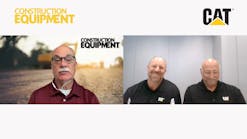Cummins is a company on fire, in every positive sense. It recently announced the acquisition of Jacobs Vehicle Systems and Meritor Inc., thus expanding, diversifying, and strengthening prospects for future sales of transportation equipment. This is well in character for the firm, because in previous years it bought several other companies that produce engine- and truck-related products, and has forged partnerships that more closely link it to truck manufacturing. The latest partner is Daimler Truck AG in Europe, which will drop its own medium-duty diesels in favor of Cummins-developed engines to be produced in Germany. Later, this might or might not affect Detroit Diesel as well as Freightliner and Western Star, all owned by Daimler Trucks North America.
Cummins partners also include Westport, designer of natural gas combustion systems that is half of Cummins Westport, which sells natural gas engines using Cummins cylinder blocks and Westport heads and fuel systems; Eaton Inc., the gearbox maker that is 50 percent of a joint venture called Eaton Cummins Automated Transmission Technologies; and Paccar Inc., owner of Kenworth and Peterbilt, which use Cummins-made medium-duty diesels sold under the Paccar PX name. Paccar also makes its own heavy duty diesels, and is thus a competitor to Cummins in the 11- to 13-liter range. KW and Pete therefore do not offer Cummins’ X12 diesel but will sell customers the larger X15 and the smaller B6.7/PX7 and L9/PX9.
Similar partial partnerships exist with other truck builders, and of course all heavy and most medium truck manufacturers are customers for Cummins power. Though proprietary engines limit Cummins’ share of diesel sales, it continues to claim high volumes and, together with extensive sales into construction, industrial, agricultural, locomotive and power-generation markets around the world, continues to prosper. The recent acquisitions will allow Cummins to offer integrated powertrains, although cooperation from truck builders will be necessary.
What Meritor means to Cummins
Meritor makes brakes, suspensions and axles, including recently developed electric-powered axles, for medium and heavy trucks. Cummins knows that part of trucking’s future involves electric propulsion, so says it is especially pleased to gain those e-axles. Meritor also markets a slew of aftermarket parts, another source of hefty revenue. Cummins is paying $3.7 billion for the company by purchasing its common stock at a considerable premium over its prior trading prices. Meritor was formerly Rockwell Automotive, spun off in 1997 by Rockwell International, the aerospace manufacturer. During World War II, Rockwell made thousands of axles for military trucks, and its successor’s axle products are still widely used by the military and are standard on many American-made commercial heavy trucks. Meritor is a direct competitor to Eaton Corp., so Cummins’ partnership with Eaton on automated gearboxes might or might not be in question.
Jacobs makes and sells the famous Jacobs Engine Brake, better known as the Jake Brake, which hydraulically alters valve action to turn a diesel into an air compressing retarder. Most truckers know the story about Clessie Cummins, of Cummins Engine fame, who after he retired in the 1950s, invented the engine retarder. He did that after almost being killed in a runaway rig on Cajon Pass in California. Clessie offered the invention to his old company, but managers didn’t see a need for retarders and turned him down. Meanwhile, Clessie’s nephew had married into the family running Jacobs Manufacturing, then known for its bit-securing chucks for hand drills. Clessie met and struck a deal with top executives of Jacobs, who wanted to diversify their company and took the engine brake to market in 1961. That’s why the device carries the Jacobs and Jake names.
Why Cummins bought Jake Brake
Over the years, the Jake Brake gradually gained acceptance among truck owners, especially those who operated in mountainous regions. Rolling downgrade in a heavily loaded truck is much easier with an engine brake, and safer, too, because it reduces use of service brakes and keeps them cool so they’re effective in emergencies. Although some hard-nosed fleet managers felt engine brakes could not be economically justified, a federal study in the 1980s concluded that reduced brake wear alone could pay the extra cost of engine brakes, even without hoped-for savings from reduced accidents.
And a Jake Brake was not cheap, costing about $2,000 in early ‘80s money. Although there were some alternatives, like exhaust restrictors (a.k.a. “potato in the tailpipe”) and hydraulic axle and driveline retarders, the Jake was the most widely used.
Its good reputation and solid federal patents on the device greatly reduced competition for Jacobs. But when the patents ran out, Cummins—seeing Clessie’s old idea making a lot of money—jumped in with its own product. Called the C Brake, it duplicated a Jake’s function, and at about half the asking price. Jacobs had to drastically lower its prices and almost overnight, engine brakes became far more affordable.
This writer’s test drives back in those days found that C Brakes weren’t as strong as Jakes, but were still worth having, particularly with Cummins’ aggressive pricing. Eventually Cummins dropped the C Brake after striking an acceptable supply deal with Jacobs, which is why you’ll find Jakes on today’s Cummins diesels (and many other diesel brands here and around the world). By the way, the engine brake on the Ram-Cummins Turbo Diesels, and on Cummins’ B and L series diesels, is the E Brake, an exhaust retarder that works through the turbocharger. In view of that, it makes immense sense that, according to the Cummins announcement in February, Jacobs Vehicle Systems will team with Cummins Turbo Technologies.
About 10 years ago, when Navistar Inc. was reeling from the failure of its EGR-only MaxxForce diesels, Cummins in effect rescued the company with its more advanced ISX engines. They kept Navistar and International Truck alive, and Cummins exhaust-aftertreatment equipment applied to Navistar engines made them workable. Eventually Navistar dropped its own diesels and used Cummins engines instead. About this time a rumor had Cummins planning to buy Navistar. I asked its chairman and CEO, Tom Linebarger, about this, and he said no, that “we wouldn’t know how to run it.” I thought he was being modest, and he acknowledged a more accurate reason: owning one truck builder would spoil Cummins’ relationships with other builder-customers. Linebarger still runs Cummins, and evidently knows exactly what he and his company are doing.







